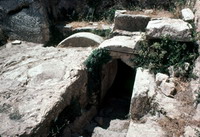Archeologists find tomb of biblical King Herod
Archaeologists from Israel had discovered the tomb of King Herod, the great builder of ancient Jerusalem whose imprint is stamped across the Holy Land.

Although the tomb was shattered and empty, leaders of the team that unearthed it say they will dig on in the hope of finding jewelry, other artifacts or even the human remains of one of the Bible's most reviled yet influential personalities.
Hebrew University archaeologist Ehud Netzer said he had been leading the search for Herod's tomb at the king's winter palace in the Judean desert, in an Israeli-controlled part of the West Bank south of Jerusalem, for 35 years. Last month his team started unearthing limestone fragments, from which emerged the picture of an ornately-carved sarcophagus with decorative urns of a type never before found in the Holy Land.
"It's a sarcophagus we don't just see anywhere," Netzer told a news conference at the university. "It is something very special."
The complete object would have been about 2.5 meters (9 feet) long, the university said.
Herod was the Jewish proxy ruler of the Holy Land under imperial Roman occupation from 37 B.C. and reigned for more than six decades. His most famous construction project was expanding the Jewish Second Temple in Jerusalem.
Remnants of his extensive building work in Jerusalem are still visible in Jerusalem's Old City, and he undertook major construction projects in Caesaria, Jericho, the hilltop fortress of Massada and elsewhere.
At the excavation site, on the steep, rocky slopes of a cone-shaped hill 680 meters (2,230 feet) high, Netzer's assistant, Yaakov Kalmar, said that an account of Herod's funeral by the first century historian Josephus Flavius left little doubt that it took place at Herodium. The newly-discovered tomb was regal in its opulence.
"We have here all the attributes of a royal funeral," Kalmar said. "We didn't find inscriptions so far...the work is not finished."
Under a baking sun, blocks of limestone, carved with borders of rosettes and geometrical designs, lay in three excavated pits backed by a flagstone buttress which Kalmar said was typical of the Herodian period.
The site sits halfway up the hill, atop a warren of tunnels and water cisterns built to serve the palace at the summit.
Stephen Pfann, an American expert in the Second Temple period at the University of the Holy Land, called the find a "major discovery by all means," but said the lack of an inscription hindered full verification.
"We're moving in the right direction. It will be clinched once we have an inscription that bears his name," said Pfann, a textual scholar who did not participate in Netzer's dig.
Eric Myers of North Carolina's prestigious Duke University, who has himself excavated in the Holy Land, said initial descriptions of the tomb pointed to its authenticity as belonging to Herod.
"We know he was buried at Herodium," hesaidin a telephone interview. "It's a significant find after a long search."
Myers said that among key clues were that the sarcophagus was placed on a raised platform rather than the underground tombs to be expected for someone of lesser rank, and that it in accordance with Jewish religious law, it was not decorated with any human image.
"It sounds as if Herod was respectful of his Jewish tradition right up to the end," he said.
David Owen, a biblical historian and archaeologist at Cornell University who has done extensive fieldwork in Israel, was not surprised by the find.
"That's where Josephus says he was buried," said Owen. "He built that entire palatial complex and there are few doubts that his tomb would be there."
The Herod of the Bible and of Christian tradition was a bloodthirsty megalomanic, who flew into a paranoid frenzy when he encountered the three wise men on the way to Bethlehem with gifts for the baby Jesus and telling of the birth of a new king of Israel.
"Then Herod, when he saw that he was mocked of the wise men, was exceedingly wroth, and sent forth, and slew all the children that were in Bethlehem, and in all the coasts thereof, from two years old and under..." (Matthew 2:16).
Kalmar said that while the discovery of Herod's tomb sheds no new historical light on Jesus, "It teaches us more about the period in general."
As well as being the stuff of Hollywood spectacle, the Herod horror story figures in paintings such as Peter Paul Rubens' 17th century "Massacre of the Innocents. "
The account, however does not appear in other Gospels, and experts are not convinced of its accuracy, especially the implications of mass infanticide. Some believe the decree applied only to Bethlehem itself, a small town at the time, where there may have been as few as 15 toddlers.
Historians do agree that toward the end of his reign Herod slaughtered large numbers of political rivals and perceived plotters against him, among them one of his 10 wives and three of his sons. Josephus says that as the elderly Herod lay riddled with disease, he ordered the cream of the local Jewish aristocracy to be executed on his demise, so that his passing would bring widespread and genuine mourning.
After Herod's death, Herodium became a stronghold for Jewish rebels fighting Roman occupation, and the site suffered significant battle damage before it was conquered and finally destroyed by Roman forces in A.D. 71, a year after they destroyed the Jewish temple in Jerusalem..
Kalmar said the sarcophagus could have been destroyed during Roman attacks or deliberately smashed by the rebels, who reviled the memory of Herod as a Roman puppet.
"We know that Herod had a lot of enemies," he said.
Roi Porat, another of Netzer's assistants on the digs, said it was possible that the Jews removed Herod's remains after his tomb was reduced to rubble.
Subscribe to Pravda.Ru Telegram channel, Facebook, RSS!





